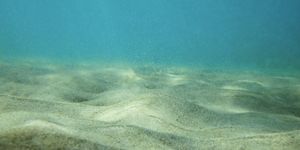A Ctenophore Is Discovered - Virtually
Researchers used video taken on an underwater expedition to establish the existence of a new species of comb jellyfish, which are also known as ctenophores. The newly-identified creature is called Duobrachium sparksae and was discovered when a remotely operated vehicle (ROV) named Deep Discoverer did a dive off the coast of Puerto Rico in 2015.
The marine animal was spotted by National Oceanic and Atmospheric Administration (NOAA) Fisheries scientists Mike Ford and Allen Collins who were working onshore, and this is the first time NOAA scientists have used video to describe and annotate a new animal. The findings have been reported in Plankton and Benthos Research.
“It’s unique because we were able to describe a new species based entirely on high-definition video. The cameras on the Deep Discoverer robot are able to get high-resolution images and measure structures less than a millimeter. We don’t have the same microscopes as we would in a lab, but the video can give us enough information to understand the morphology in detail, such as the location of their reproductive parts and other aspects,” said Collins.
Physical samples of the animal were not taken, but we have the video to characterize its features. Three observations were made.
“We didn’t have sample collection capabilities on the ROV at the time. Even if we had the equipment, there would have been very little time to process the animal because gelatinous animals don’t preserve very well; ctenophores are even worse than jellyfish in this regard. High-quality video and photography were crucial for describing this new species,” Collins explained.
There are typically eight rows of beating cilia on comb jellies, which refract light as they move through the water. There are about 125 species of ctenophores that have been identified. Despite their name, they are not related to jellyfish.
“It was a beautiful and unique organism,” said Ford. “We collected high-definition video and described what we saw. We went through the historical knowledge of ctenophores and it seemed clear this was a new species and genus as well. We then worked to place it in the tree of life properly.
“Naming of organisms is guided by international code, but some changes have allowed descriptions of new species based on video; certainly when species are rare and when collection is impossible,” Ford continued. “When we made these observations, we were 4,000 meters down, using a remote vehicle, and we did not have the capabilities to take a sample.”
“Video identification can be controversial,” Collins added. “For example, some insect species descriptions have been done with low-quality imagery and some scientists have said they don’t think that’s a good way of doing things. But for this discovery we didn’t get any pushback. It was a really good example of how to do it the right way with video.”
The video does provide evidence of the animal's physiology and behavior.
“The ctenophore has long tentacles, and we observed some interesting movement. It moved like a hot air balloon attached to the seafloor on two lines, maintaining a specific altitude above the seafloor,” Ford said. “Whether it’s attached to the seabed, we’re not sure. We did not observe direct attachment during the dive, but it seems like the organism touches the seafloor.”
There’s still a lot to learn about this new species. The videos are now part of the publicly-accessible Smithsonian National Museum of Natural History Collection and can be used to help describe and name the animal.
Sources: NOAA, Plankton and Benthos Research








